Chronic maternal infusion of full-length adiponectin in pregnant mice down-regulates placental amino acid transporter activity and expression and decreases fetal growth
- PMID: 22289908
- PMCID: PMC3382336
- DOI: 10.1113/jphysiol.2011.226399
Chronic maternal infusion of full-length adiponectin in pregnant mice down-regulates placental amino acid transporter activity and expression and decreases fetal growth
Abstract
Maternal adiponectin levels are inversely correlated to birth weight, suggesting that maternal adiponectin limits fetal growth. We hypothesized that full-length adiponectin (fADN) infusion in pregnant mice down-regulates placental amino acid transporters and decreases fetal growth. Starting at embryonic day (E) 14.5, fADN (0.62 ± 0.02 μg (g body weight)(−1) day(−1), n = 7) or vehicle (control, n = 9) were infused in pregnant C57/BL6 mice by mini-osmotic pump. At E18.5, dams were killed and placental homogenates and trophoblast plasma membrane (TPM) vesicles were prepared. Infusion of fADN elevated maternal serum fADN by 4-fold and decreased fetal weights by 18%. Adiponectin receptor 2, but not adiponectin receptor 1, was expressed in TPM. fADN infusion decreased TPM System A (–56%, P < 0.001) and System L amino acid transporter activity (–50%, P < 0.03). TPM protein expression of SNAT1, 2 and 4 (System A amino acid transporter isoforms) and LAT1 and LAT2, but not CD98, (System L amino acid transporter isoforms) was down-regulated by fADN infusion. To identify possible mechanisms underlying these changes we determined the phosphorylation of proteins in signalling pathways known to regulate placental amino acid transporters. fADN decreased phosphorylation of insulin receptor substrate-1 (Tyr-608), Akt (Thr-308 and Ser-473), S6 kinase 1 (Thr-389), eukaryotic initiation factor 4E binding protein 1 (Thr-37/46 and Thr-70) and ribosomal protein S6 (Ser-235/236) and increased the phosphorylation of peroxisome proliferator-activated receptor α (PPARα) (Ser-21) in the placenta. These data suggest that maternal adiponectin decreases fetal growth by down-regulation of placental amino acid transporters, which limits fetal nutrient availability. This effect may be mediated by inhibition of insulin/IGF-I and mTOR signalling pathways, which are positive regulators of placental amino acid transporters. We have identified a novel physiological mechanism by which the endocrine functions of maternal adipose tissue influence fetal growth.
Figures


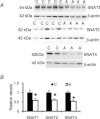
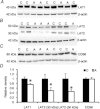
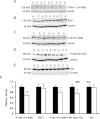
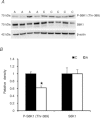
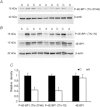
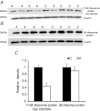
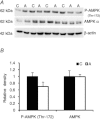
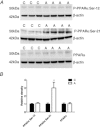
Similar articles
-
Maternal protein restriction in the rat inhibits placental insulin, mTOR, and STAT3 signaling and down-regulates placental amino acid transporters.Endocrinology. 2011 Mar;152(3):1119-29. doi: 10.1210/en.2010-1153. Epub 2011 Feb 1. Endocrinology. 2011. PMID: 21285325 Free PMC article.
-
Adiponectin supplementation in pregnant mice prevents the adverse effects of maternal obesity on placental function and fetal growth.Proc Natl Acad Sci U S A. 2015 Oct 13;112(41):12858-63. doi: 10.1073/pnas.1515484112. Epub 2015 Sep 28. Proc Natl Acad Sci U S A. 2015. PMID: 26417088 Free PMC article.
-
Adiponectin inhibits insulin function in primary trophoblasts by PPARα-mediated ceramide synthesis.Mol Endocrinol. 2014 Apr;28(4):512-24. doi: 10.1210/me.2013-1401. Epub 2014 Feb 25. Mol Endocrinol. 2014. PMID: 24606127 Free PMC article.
-
Review: Adiponectin--the missing link between maternal adiposity, placental transport and fetal growth?Placenta. 2013 Mar;34 Suppl:S40-5. doi: 10.1016/j.placenta.2012.11.024. Epub 2012 Dec 13. Placenta. 2013. PMID: 23245987 Free PMC article. Review.
-
The emerging role of mTORC1 signaling in placental nutrient-sensing.Placenta. 2012 Nov;33 Suppl 2(Suppl 2):e23-9. doi: 10.1016/j.placenta.2012.05.010. Epub 2012 Jun 10. Placenta. 2012. PMID: 22687819 Free PMC article. Review.
Cited by
-
Quantitative Proteomics of Maternal Blood Plasma in Isolated Intrauterine Growth Restriction.Int J Mol Sci. 2023 Nov 27;24(23):16832. doi: 10.3390/ijms242316832. Int J Mol Sci. 2023. PMID: 38069155 Free PMC article.
-
Maternal obesity and metabolic risk to the offspring: why lifestyle interventions may have not achieved the desired outcomes.Int J Obes (Lond). 2015 Apr;39(4):642-9. doi: 10.1038/ijo.2015.15. Epub 2015 Jan 5. Int J Obes (Lond). 2015. PMID: 25777180 Free PMC article. Review.
-
Complex, coordinated and highly regulated changes in placental signaling and nutrient transport capacity in IUGR.Biochim Biophys Acta Mol Basis Dis. 2020 Feb 1;1866(2):165373. doi: 10.1016/j.bbadis.2018.12.024. Epub 2019 Jan 23. Biochim Biophys Acta Mol Basis Dis. 2020. PMID: 30684642 Free PMC article. Review.
-
Activation of placental insulin and mTOR signaling in a mouse model of maternal obesity associated with fetal overgrowth.Am J Physiol Regul Integr Comp Physiol. 2016 Jan 1;310(1):R87-93. doi: 10.1152/ajpregu.00356.2015. Epub 2015 Oct 21. Am J Physiol Regul Integr Comp Physiol. 2016. PMID: 26491103 Free PMC article.
-
Regulation of placental amino acid transport in health and disease.Acta Physiol (Oxf). 2024 Jul;240(7):e14157. doi: 10.1111/apha.14157. Epub 2024 May 6. Acta Physiol (Oxf). 2024. PMID: 38711335 Free PMC article. Review.
References
-
- Abbud W, Habinowski S, Zhang JZ, Kendrew J, Elkairi FS, Kemp BE, Witters LA, Ismail-Beigi F. Stimulation of AMP-activated protein kinase (AMPK) is associated with enhancement of Glut1-mediated glucose transport. Arch Biochem Biophys. 2000;380:347–352. - PubMed
-
- Ategbo JM, Grissa O, Yessoufou A, Hichami A, Dramane KL, Moutairou K, Miled A, Grissa A, Jerbi M, Tabka Z, Khan NA. Modulation of adipokines and cytokines in gestational diabetes and macrosomia. J Clin Endocrinol Metab. 2006;91:4137–4143. - PubMed
-
- Barker DJ, Hales CN, Fall CH, Osmond C, Phipps K, Clark PM. Type 2 (non-insulin-dependent) diabetes mellitus, hypertension and hyperlipidaemia (syndrome X): relation to reduced fetal growth. Diabetologia. 1993;36:62–67. - PubMed
-
- Boney CM, Verma A, Tucker R, Vohr BS. Metabolic syndrome in childhood: Association with birth weight, maternal obesity, and gestational diabetes. Pediatrics. 2005;115:e290–e296. - PubMed
-
- Caminos JE, Nogueiras R, Gallego R, Bravo S, Tovar S, Garcia-Caballero T, Casanueva FF, Dieguez C. Expression and regulation of adiponectin and receptor in human and rat placenta. J Clin Endocrinol Metab. 2005;90:4276–4286. - PubMed
Publication types
MeSH terms
Substances
Grants and funding
LinkOut - more resources
Full Text Sources
Medical
Molecular Biology Databases
Research Materials
Miscellaneous

